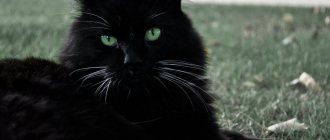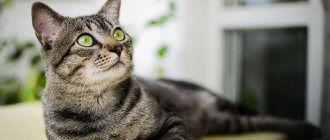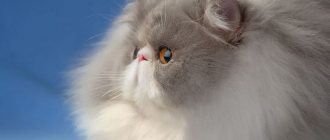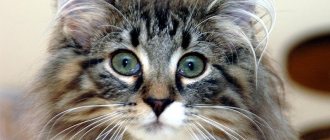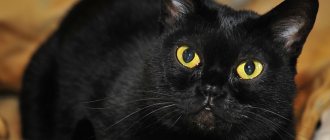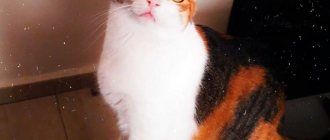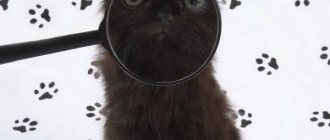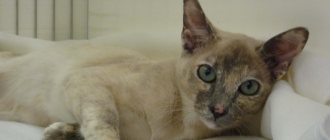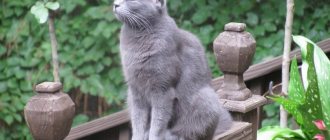History of the origin of the Chinese cat
The exact origin of this natural cat breed is unknown. According to the most common version, they are direct descendants of wild cats that lived in the mountainous regions of China . Mentions of similar cats and their images can be found in the oldest handwritten documents from the time of the brilliant and powerful Tang dynasty (VI-X centuries).
An image of a cat similar to Li Hua can be seen in ancient Chinese manuscripts
However, it was only in 2003 that Li Hua took part in the exhibition for the first time, which was held in Beijing. The first representative of the breed, the cat Needy, even took a prize and received the title of champion in his category. In the same year, a pair of animals (Zhong Guo and Nao Nao) were exported to the USA for breeding. Preliminary standard characteristics were developed over two years and were officially adopted in 2005. In February 2010, at a meeting of the CFA Council, the Chinese cat received international recognition and status in the miscellaneous class.
History of the discovery of the species
It is not known for certain where the animals came from; they approximately inhabited the territory of China long before the appearance of people and lived in desert areas. The separation of the Chinese and European (forest) cats occurred 230 thousand years ago. The cat was first described by the French zoologist and naturalist Henri Milne-Edwards in 1892. These animals lived in China long before the appearance of pets in Europe, where they were brought after the opening of economic borders.
Today, the Desert Cat is a small species, numbering from 2,500 to 10,000 adult individuals according to various sources, and these data are inaccurate. Not all animals have been domesticated by humans; small groups live in the remaining undeveloped areas of China.
Today they are facing extinction, as residential and industrial buildings occupy new territories every day, leaving no room for wildlife.
Appearance of Chinese cats dragon li
CFA standards require li hua to meet the following characteristics:
- The physique is proportionately strong, well-built and muscular. Height at the withers: cat - 35–38 cm;
- cats - 27–30 cm.
- male - 4.5–5.5 kg;
Li Hua cats are not very large, but strong and powerful
Features of color
The colors of Chinese cats are extremely spectacular and bright. Standard requirements allow the only possible option - a black mackerel tabby (Brown Mackerel Tabby). Clear black stripes cover the back and sides of the animal, crumbling towards the abdomen into small round button spots. The lines on the legs are looped, the paws are solid dark brown. The tail is also covered in rings, but the very tip is always black.
For a Chinese cat, only black brindle tabby color is allowed
On the chest there must be at least one, or preferably several, necklaces representing continuous black stripes. A large dark letter “M” should be clearly visible on the forehead above the eyes. The eyes are outlined with a black edging; thin black lines run from their outer corners along the cheeks to the neck. All fur is ticked (dyed in several colors), that is, each hair is jet black at the base, light beige in the middle, and chestnut at the tip.
The interesting illusion of a smile in the Chinese Li Hua is explained by the presence of black dots at the corners of the mouth.
Li Hua's eyes should be yellow-greenish.
Individuals with the following serious defects are subject to disqualification:
- inconsistency with color (white paws or muzzle, lack of necklace stripes on the chest, etc.);
- any color of the iris, except yellow, brown and green;
- curly or elongated coat;
- light nose skin;
- excess or insufficient number of fingers;
- malocclusion;
- tail defects (bends, creases, etc.).
The disadvantages are:
- fuzzy tabby pattern on the skin;
- excess weight;
- disproportionately large ears;
- not slanted eyes;
- narrow or wide forehead.
Photo gallery: Chinese Li Hua cats
Chinese cats are natural hunters
Chinese cats, like all felines, love to soak up the sun.
Kittens stay with their mother for at least 14–16 weeks
Li Hua cats have a calm and balanced disposition.
Li Hua cats participate in exhibitions
Li Hua cats are depicted on postage stamps
Most often, the eyes and li hua cats are colored a mixed greenish-yellow shade.
Reproduction
Little is known about the breeding system of Gobi gray cats, but they are closely related to jungle cats, which exhibit mate promiscuity, meaning that both sexes, males and females, mate with multiple partners. This species lives in solitary burrows, except during the breeding season, when the female and male live together.
The breeding system is polygynous. Mating occurs from January to March, and kittens are born in May. The gestation period is unknown. The number of kittens in a litter varies from 2 to 4. Mothers care for the young generation in burrows, where they are safe from predators. Kittens become independent after 7-8 months. Wolves (Canis lupus) and brown bears (Ursus arctos) can kill cubs.
There is no information regarding parental involvement in raising the offspring, but among their relatives, the marsh lynxes (Felis chaus), females are responsible for raising and feeding the kittens. Fathers sometimes stay close to defend the territory.
Character and behavioral characteristics of the Chinese cat Dragon Li
Li Hua cats are distinguished by their independence and independent disposition . They love affection, but they will not sit all day long on their master’s lap. These are calm and patient animals, they love to run and play, they are devoted to their owner, but in his absence they do not get bored at all. They must be provided with enough space for free movement and outdoor games; in small rooms the descendants of wild mountain cats are extremely uncomfortable.
Chinese Li Hua cats have a calm and independent character.
In order for your Li Hua cat to have a place to frolic, you need to purchase or make your own multifunctional play complex, which will include beds, houses, ladders, tunnels, scratching posts, scratchers, scratchers, toys and other interesting devices.
Like all cats, Li Huas are extremely inquisitive, or rather, curious. They will definitely come out to look at the guests, but only from afar, since the breed is not known for its gullibility. The excellent hunting qualities of pets of Chinese origin have been noted; there will never be rats, mice or even flies in the house. For this reason, it is not recommended to keep birds, hamsters and other small animals, which mustachioed hunters always perceive as prey.
Chinese cats tolerate small children steadfastly, but not for long. They may well use their teeth and claws if they feel violence against their own personality. Although they get along peacefully with other cats and dogs. Pets get very used to the house, do not tolerate moving well and have difficulty adapting to new premises. Li Huas are endowed with extraordinary intellectual abilities, are easy to train, and can also perform simple commands and tricks.
Chinese cats can be trained to fetch various items
While searching for information on Chinese cats, I discovered a historical fact that a certain well-known political figure in China - the revolutionary Zhao Shangcai - trained his own cats to carry newspapers for him.
Video: dragon li cat playing
Mr. Cat recommends: characteristics, habitat
The appearance of the Chinese mountain cat is not much different from the domestic animal we are used to. It is larger than its European counterparts, but very similar to them. In addition, he is practically a copy of the jungle cat, although his paws are slightly shorter, but he also has tufts on his ears. The animal's muzzle is extended forward, its coat color is yellowish-red with characteristic stripes. By the way, in Chinese the name of the species sounds like huang mo mao, which means a cat with yellow fur.
Forest or European cat
jungle cat
Chinese cat
In addition, we can say that the Desert Cat is similar to a lynx, only different in size. The tail is thick with black transverse rings located towards the end.
Wild individuals reach up to 1.4 meters in length including the tail (it is 25-35 cm) and weigh 6-9 kg. Males are larger than females.
In nature, they can be found in the northwestern part of China. The animals live in steppe and mountainous regions near the border of Tibet and in southern Mongolia.
Observations by local residents indicate that Gobi cats live in extreme conditions at an altitude of 2000 to 4000 meters above sea level in the steppes of the foothills. Sharp temperature changes reaching critical levels in winter and summer, strong winds - these are the conditions chosen by the most ancient representatives of the cat family.
In the process of evolution, the fur of these animals became denser and thicker, and peculiar slippers were formed on their paws, protecting the pads from cold and heat.
Previously, the animal was an object of hunting. As a result of this, and also due to the mass extermination of rodents that the animal ate, the number of Mountain cats decreased. Now they are under state protection and are listed in the Red Book as an endangered species.
Health of Chinese cats
Since the breed of Chinese cats is indigenous and has never been subjected to selection intervention, their immunity is strong and their health is good . No hereditary diseases or frightening pathologies were found in them. Life expectancy is approximately 15–18 years.
Some owners of this breed claim that Li Huas tolerate drafts very poorly, as well as temperature changes due to their short coat and lack of undercoat.
Enemies and food
Unfortunately, the Chinese cat breed receives the predominant percentage of dangers from humans. This is due to the constant hunting of its representatives and the spread of poisons dangerous to it.
The first and main reason for the decline in the population of this breed is the almost complete elimination of prey. Back in 1958, instructions were given to destroy all rats and rodents. This would significantly reduce the number of zokors, which posed a direct threat to livestock. The main chemical used to exterminate them was zinc phosphide. Over time, it was no longer used because scientists had proven its harmful effects on all carnivores that consumed rodents as food.
This Chinese cat with big eyes, in addition to the animals presented, also consumes rabbits, pheasants and other representatives.
Features of keeping and caring for Chinese cats
There are no special worries in the maintenance of Li Hua.
Nutrition
Chinese Li Huas eat both commercially prepared (dry and wet) food and natural food with equal pleasure. Prepared food must be at least premium class (preferably higher). For example:
- Royal Canin FIT 32;
- Orijen Cat & Kitten Grain Free;
- Acana Regionals Grasslands Cat Grain-Free;
- Applaws Adult Cat Chicken Grain Free;
- Hill's Nature's Best.
1st Choice Adult dry food is an ideal formula for indoor cats with special carefully selected ingredients
A natural diet should consist of:
- beef or veal meat (frozen);
- boiled offal (heart, lungs, etc.);
- hare, rabbit, turkey, chicken;
- boiled sea fish (without bones);
- fresh and boiled vegetables (carrots, zucchini, cabbage, spinach, turnips, etc.);
- eggs (preferably quail);
- cereals (buckwheat, barley, etc.);
- low-fat fermented milk (kefir, cottage cheese, unsweetened yogurt, etc.).
When feeding natural food, pets should be given vitamin and mineral supplements.
Gimpet Kase-Rollis cheese balls with multivitamin for cats - a new product from the German company Gimpet combines three functions: a delicious treat with mascarpone cheese, an exciting game for cats and a functional food supplement with vitamins
Adult animals are fed twice a day (morning and evening). The serving size per meal is calculated from the ratio of 35–40 g (natural food) or 17–20 g (freeze-dried food and canned food) per 1 kg of pet’s live weight. Kittens are fed 4–5 times a day (after 6 months three times), the daily norm is about 200–250 g.
Any cat is prohibited from being given smoked, peppered, spicy, spicy and sweet foods, as well as pork, legumes, river fish and citrus fruits.
Necessary living conditions
The Chinese cat needs to be provided with a comfortable and cozy sleeping place (bed, basket, house), as well as a couple of bowls for food and fresh water. A prerequisite is the presence of a vertical, firmly fixed scratching post (preferably several), otherwise the situation in the house may suffer.
You can find special scratching posts on sale
All cats love to survey the territory under their control from the highest vantage point possible. Our cat constantly climbs onto the refrigerator, because from there she can see almost everything that happens in the house. Experienced cat owners recommend attaching several shelves to the walls so that the pet can lie there and carefully observe everything.
Hygiene measures
Caring for a li how is very simple. Need to:
- Once every 3-4 weeks, cut off the tips of the claws by 1-2 mm, being careful not to touch a blood vessel. There are special protective caps that are placed on the claws of the front paws and fixed with glue. The covers fall off on their own as the horny plate grows. But anti-scratch pads cause certain inconvenience to cats, as they interfere with scratching, climbing on vertical surfaces and prevent their claws from being fully retracted.
To prevent the cat from tearing furniture and wallpaper, anti-scratch guards are placed on its claws.
- Wipe your eyes daily with special veterinary compounds (Cliny C, Nature SaniPet). If they are not available, you can use tea leaves, herbal decoction (chamomile, marigold, etc.) or warm boiled water.
- Once every 10–15 days, clean the ears with a cotton swab dipped in hydrogen peroxide, chlorhexidine or a special product (ABZ Bars, Hartz, etc.).
- Brush the coat with a special rubber brush or mitten once a week. During heavy molting, this is done daily.
- Bath no more than 1-2 times a year. After the procedure, it is recommended to thoroughly dry the cat with a towel and dry its fur with a hairdryer so that it does not catch a cold. It is better to wash with special shampoos: Bio-Groom Silky Cat Shampoo;
- Espree Shine of silk;
- Ms.Kiss Graceful Panther;
- Perfect Coat;
- Ecoprom CLINY;
- Gamma.
Veterinarians advise cleaning your cat’s teeth every 5–7 days using a special toothpaste and brush.
Photo gallery: shampoos for Chinese cats
Bio-Groom Silky Cat Shampoo - shampoo-conditioner for cats is developed on the basis of unripe coconut oil, which moisturizes the coat and gives it extra shine and silkiness Shampoo Shine of Silk gently cleanses, moisturizes and gives the coat a healthy and well-groomed appearance Ms.Kiss Shampoo Graceful Panther for short-haired cats, developed on the basis of the latest Swiss technology, provides shine, tight fit, straightening, elasticity and smoothness of the cat's coat Perfect Coat - shampoo + conditioner, con for kittens and cats Gamma Shampoo for smooth-haired cats contains high-quality detergent ingredients, conditioning additives, group vitamins A, B, E, natural waxes obtained from pine and pine needles Cliny shampoo for kittens is created for gentle care of the skin and hair.
Features of mating Chinese Li Hua cats
Chinese cats develop more slowly than other representatives of the cat world. They reach sexual maturity only after three years. It is strictly not recommended to breed them earlier, since early pregnancy can result in a miscarriage or even the death of the cat. Males are ready to mate after about two years of age. As a rule, a sexually mature female Li Hua does not have problems during the gestation period. Childbirth is easy and natural. Representatives of this slowly maturing breed can give birth no more than once a year.
Individuals that do not meet breed standards or have unacceptable defects are not allowed to breed and are subject to castration or sterilization to avoid unwanted matings. The operation is carried out only after the final puberty of the animal, i.e. not earlier than three years (cats after two).
It is difficult to find a partner for a Chinese cat
Breeding Chinese cats is extremely difficult, not only because of their small numbers, but also because of the low popularity of this breed. Visually, only a specialist can distinguish a purebred Li Hua from a simple yard dog. It will not be possible to find a partner for a pet in Russia; to do this you will have to visit China or the USA. When choosing a pair, consider the following:
- appearance of a potential partner: compliance with breed characteristics;
- health and activity.
Pedigree cats must have pedigrees
Cat lovers I know say that when a breeder has few breeding animals, he often resorts to inbreeding. This fact negatively affects the health of the offspring, since the chances of developing genetic diseases or physical defects increase significantly. You should carefully study the pedigree up to the fourth generation.
Purchasing a kitten
Purchasing a wild animal with the character of a predator is a responsible decision. The animal needs a large territory and loneliness; individuals, accustomed to living alone in nature, are forced to be in the spotlight and show aggression.
It is especially dangerous to keep a Mountain Cat with other animals. Pets will conflict and can cause irreparable harm to each other. Victory will be on the side of the wild animal, which is stronger and larger than domestic ones.
Breeders need to know that sterilization of the Chinese mountain cat is contraindicated. He does not tolerate anesthesia well and if he survives, his character changes for the worse. Keeping such animals outside the cage is dangerous for the owner.
When purchasing a pair, even experienced breeders take risks. It is impossible to be sure that animals will be able to reproduce in captivity, since the choice of a mate in cats usually occurs during the breeding season. During the rut, animals that have not found a mate become aggressive towards their own kind, and at home they can attack the owner, perceiving him as a rival.
There is no question of the Mountain Cat living in an apartment. This is deliberate murder. Living in a closed space leads to illness and death of the pet. It is impossible to toilet train an animal; it will mark its territory no matter what, as this happens in nature.
Considering the characteristics of the animal, it is better to leave it to live in nature or, in extreme cases, in a reserve or zoo with excellent conditions and competent specialists. For the home, it is recommended to purchase artificially bred breeds adapted for small spaces and constant contact with humans.
How to choose the right Chinese cat kitten
Finding a Li Hua kitten is extremely difficult; there are several nurseries only in China . The cost of such precious and rare cats starts from a thousand dollars.
When choosing a kitten, consider:
- Age. A conscientious breeder will never give a baby to a Li Hua until it reaches 12-16 weeks and has had all its vaccinations. Only after this the little pet will be ready to move.
- Healthy appearance (clean ears, eyes and nose). The kitten should be active, cheerful and not timidly hide in corners.
- Absence of physical defects (wrong bite, number of fingers, etc.).
- Compliance with breed standards (color, eye color, etc.).
- Pedigree and veterinary record indicating vaccinations given.
It is very difficult to find a Chinese cat kitten
From my own experience, I will say that under no circumstances should you buy kittens based on an ad on “Buy and Sell” sites. Simple outbred animals are often passed off as highly purebred individuals, and sometimes not at all for selfish reasons. After looking at advertisements for the sale of Li Hua cats just today, I came across a couple in which kittens were sold for only 500 rubles. A real Chinese cat cannot cost that much, although visually it is unremarkable.
Captivity
The Chinese desert cat is listed in the Red Book, so keeping an animal at home is punishable by law.
Despite the prohibitions, you can find exotic animal babies on the black market. When purchasing a wild animal that is not adapted to living at home, you need to understand that improper care, territorial limitations and nutrition can lead to negative consequences.
A Chinese cat, accustomed to freedom and harsh natural conditions, can get sick and die in the house.
When feeding domesticated predators with natural products, the owner faces difficulties in selecting and balancing the diet, but for experienced breeders this is not a problem.
Table: advantages and disadvantages of the Li Hua breed
| pros | Minuses |
|
|
Character
Cats of the Li Mao breed are highly active and friendly. They do not show intrusiveness or aggression. They get along well with other animals... and, at the same time, are considered unsurpassed hunters - owners of pet rats, guinea pigs, hamsters, etc. need to take this into account.
It is better to have a pet of this breed in a house where there are no very small children (since “dragons” do not like excessive squeezing and caressing).
Also, Li Hua are very smart and loyal cats and are quite trainable. It is quite easy to train them to go to the litter box or sharpen their nails on a special scratching post.
The Li Mao breed is perfect for keeping in a small apartment. If the owners are on duty during the day, they can tolerate loneliness without any problems.
